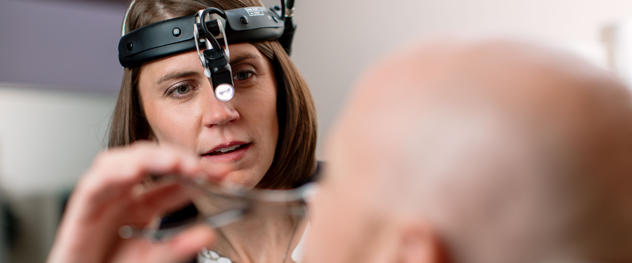-

Patient-centered research
Clinician-investigators in the Department of Otolaryngology — Head and Neck Surgery connect research and patient care to address unmet clinical needs.
-

Finding long-term surgical solutions
Department faculty members are focused on improving outcomes and long-term quality of life in patients undergoing head and neck surgery.
-

Solving clinical challenges
Researchers in the Department of Otolaryngology — Head and Neck Surgery develop medical and surgical solutions for patients with complex medical conditions.
-

Wide-ranging research impact
Advances improve health for children and adults, patients with acute and chronic conditions, and patients in clinical and surgical settings.
-

Multidisciplinary research drives improved care
With researchers actively involved in nearly every facet of otolaryngology, Mayo Clinic leads the field in advancing knowledge to deliver world-class patient care.
Overview
Investigators in the Department of Otolaryngology — Head and Neck Surgery study diseases and conditions of the head and neck, including the ear, nose and throat. Department members have a wide range of expertise and interests across the field but are united by a commitment to improving patient care through research.
Collaborative research to meet clinical needs
Otolaryngology is unique in that specialists care for children and adults, people with acute and chronic conditions, and patients in clinical and surgical settings. Otolaryngologists depend on a multidisciplinary group of experts to deliver complete and comprehensive patient care.
Mirroring these clinical needs, otolaryngology researchers identify long-term solutions to diverse clinical problems, including multiple types of cancer, hearing loss, sinus problems, sleep apnea, voice disorders, and many other diseases and conditions.
Researchers delve into the data provided by Mayo Clinic's high volume of clinical and surgical patients to answer questions that inform best practices in patient care. Some run prospective randomized clinical trials that offer patients access to cutting-edge medical and surgical advances. Others use immunology-based approaches, perform whole-exome or whole-genome sequencing, and advance 3D-printing and anatomical modeling technology. Watch Mayo Clinic’s documentary about 3D printing, Pursuing Possible, to learn more.
Perhaps most importantly, researchers in the Department of Otolaryngology — Head and Neck Surgery are typically members of multidisciplinary research teams. These collaborations improve the quality and value of investigations by diversifying perspectives, tying in a broad range of skill sets and ultimately increasing the impact research can have on clinical practice.
A diverse, dedicated research team
Clinician-investigators and basic scientists alike have built a solid research foundation within Mayo Clinic's Department of Otolaryngology — Head and Neck Surgery. Departmental interests span the breadth of otolaryngology, which is reflected in a diverse research team that includes:
- M.D. and Ph.D. clinician-investigators
- Doctoral-level basic science researchers
- Research trainees
- Advanced practice clinicians
- Speech-language pathologists
- Nurses
- Research coordinators
- Statisticians
- Lab technicians
The department's faculty and staff are motivated, productive, and dedicated to finding solutions to problems that will improve the lives of current and future patients. With researchers actively involved in nearly every facet of otolaryngology, Mayo Clinic is committed to advancing field-leading science to deliver world-class patient care.
Review the faculty roster.
Funding
Research in the Department of Otolaryngology — Head and Neck Surgery is supported intramurally and through the generosity of donors and benefactors.
Researchers have also won highly competitive funding, including National Institutes of Health R01 grants and Department of Defense grants. Investigators patent discoveries and work closely with industry partners.